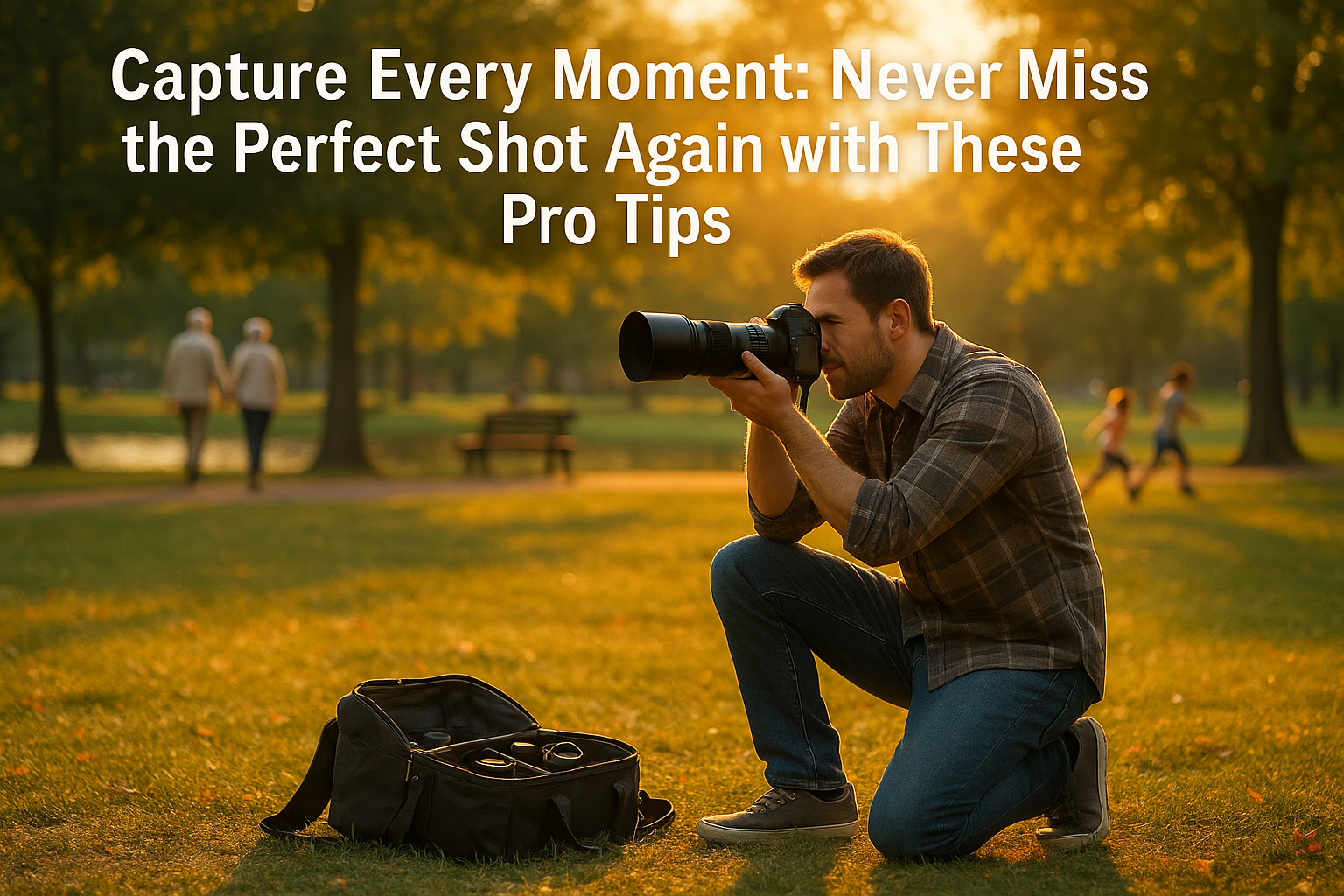📸 Every moment is a story waiting to be told, and every picture has the potential to narratively express that very story in a way words can’t. The art of photography is not just about clicking a button on a camera but a play of light, a dance of shadows, and most importantly, a perception of the world through the photographer’s eye.
Whether you are a professional photographer looking to brush up your skills, an enthusiast seeking to take your passion to the next level, or simply an individual who doesn’t want to miss the perfect shot again, this article is for you. 🙌
This comprehensive guide will unravel the most valuable pro tips to help you capture every moment beautifully and authentically. In a world where we are constantly bombarded with digital images, it’s more important than ever to understand how to make your shots stand out, be memorable, and tell a captivating story.
Stay with us, and you will learn how to harness the power of composition, understand the subtle art of lighting, the role of perspective, and how to make the most of your camera settings. 💡 Furthermore, we will delve deep into the aspects of post-production, an often overlooked but a game-changing aspect of photography.
What Awaits You in This Article?
Our conversation will begin with the basics – understanding your camera. Whether you’re using a DSLR, a mirrorless camera, or even a smartphone, knowing the intricacies of your tool is a primary step in becoming a pro. With this knowledge, you can defy the constraints of auto-mode and unlock the true potential of your camera.
Next, we will delve into the principles of composition and the vital role it plays in enhancing the aesthetic value of your photos. The rule of thirds, leading lines, or the use of natural frames can transform your everyday shots into professional-quality images.
Following that, we’ll throw light on the art of lighting, a fundamental element in photography. You’ll understand how to manipulate natural and artificial light sources to your advantage, creating an atmosphere that aligns with your artistic vision. 🌅
Then, we’ll shift our focus to the world of perspectives, where you’ll learn to see your subjects from a whole new angle. This knowledge will enable you to bring a refreshing and innovative approach to your photographs.
Finally, we will touch upon the topic of post-production, teaching you how to fine-tune your images with various software tools, enhancing their visual appeal and narrating your story more effectively. 🎨
So, are you ready to dive into the ocean of photography and uncover the pearls of wisdom that will elevate your photographic skills to new heights? Let’s get started.
Keep in mind, photography is a journey rather than a destination. It’s a process of constant learning, experimenting, and most importantly, expressing your unique perspective. As you progress through this guide, remember that practice makes perfect, and every shot you take brings you one step closer to mastering the art of capturing every moment. 🚀
Master the Art of Photography: Elevate Your Skills with These Pro Tips
Do you ever marvel at the stunning photos in a magazine or on an Instagram feed and wonder how the photographer captured such a perfect shot? If so, you’re not alone. Many of us strive to take better photos, whether we’re snapping pics of our pets, capturing family moments, or chronicling our travels. Fortunately, with some pro tips and practice, you can take your photography skills to the next level. Let’s dive into some key techniques and tools that can help you seize every moment with your camera. 📸
First, let’s consider the equipment. A professional photographer once said that the best camera is the one you have with you. While professional DSLR cameras offer an array of advanced features, don’t underestimate the power of a good smartphone camera. Many of the recent models provide exceptional photo quality and a range of features like portrait mode and night mode. But, whether you’re shooting with a high-end DSLR or a smartphone, understanding your camera’s settings and capabilities is crucial. If you’re using a DSLR, learn about the manual mode, shutter speed, aperture, and ISO. If you’re using a smartphone, explore the various modes and settings. For more insight on this topic, check out the YouTube video ‘Master Your Camera’s Manual Mode’ by Peter McKinnon.
Now, let’s move on to composition and framing. These elements can make or break a photo. They guide the viewer’s eye and can transform an ordinary snapshot into a breathtaking image. A well-known rule in this field is the Rule of Thirds. This rule suggests that an image should be divided into nine equal parts, and the subject should be placed along these lines or their intersections. Another useful tip is to fill the frame with your subject, leaving little to no space around it. This technique can emphasize the subject and eliminate distracting background elements.
Understanding Light: Your Greatest Ally in Photography
Lighting plays a significant role in photography. Whether you’re capturing a stunning sunset or a striking portrait, understanding the basics of light can greatly enhance your photos. The golden hour—typically the hour after sunrise and the hour before sunset—provides a warm, soft light that can add a magical touch to your images. Similarly, the blue hour—the period before sunrise and after sunset—offers a cool, ethereal light. Avoid shooting in harsh midday light, which can result in overexposed images and harsh shadows. To learn more about lighting in photography, watch the YouTube video ‘Understanding Light for Better Landscape Photography’ by Thomas Heaton.
Another important aspect of lighting is the direction of the light. Side lighting can add depth and texture to an image, while backlit scenes can create a stunning silhouette or a dreamy glow around the subject. Front lighting, although often less desirable, can work well in certain situations, such as when you want to highlight the colors of a landscape at sunrise or sunset.
Using flash wisely can also improve your photos. A common mistake is to use flash in dark environments, which can result in harsh, unflattering light. Instead, use flash to fill in shadows in brightly lit environments or to add a catchlight in the subject’s eyes in a portrait. Remember, flash is not just for dark environments; it’s a tool to enhance light where needed.
Editing: The Final Touch to Your Masterpiece
Once you’ve captured your photo, editing is the next step to bring your vision to life. Editing allows you to fine-tune the colors, brightness, contrast, and more in your image. Two popular tools for editing are Adobe Lightroom and Photoshop. Lightroom is great for general edits like color correction and exposure adjustments, while Photoshop offers more advanced features like layering and retouching. If you’re editing on your smartphone, apps like Snapseed and VSCO are good options. To learn more about editing, check out the YouTube video ‘Beginner’s Guide to Photoshop’ by PHLEARN.
When editing, it’s important to not overdo it. Keep your edits subtle and aim to enhance the image rather than drastically change it. Remember, the best photos are often the ones that look natural and real. The goal is to highlight the beauty that already exists in the shot, not to create it from scratch.
Finally, don’t forget to experiment and have fun with your photography. Each photo you take is a chance to learn and improve. So, grab your camera, get out there, and start capturing the world around you. 🌍📸
Pro Tips for Photography – A Comparative Table
| Aspect | Tips |
|---|---|
| Equipment | Understand your camera’s settings and capabilities. The best camera is the one you have with you. |
| Composition and Framing | Use the Rule of Thirds and fill the frame with your subject. |
| Lighting | Utilize the golden hour and blue hour. Understand the direction of light. Use flash wisely. |
| Editing | Use tools like Lightroom and Photoshop. Keep edits subtle and natural. |
For further exploration, you can refer to the YouTube videos mentioned above. They offer invaluable insights and demonstrations that can enhance your understanding and application of these pro tips. Remember, the world is your canvas, and your camera is your paintbrush. So go ahead and start creating your masterpieces! 🎨

Conclusion
In wrapping up this comprehensive guide, let’s revisit the key points we covered, summarizing the critical aspects we’ve discussed throughout the piece. We began our journey by introducing the concept and significance of software engineering, explaining how this discipline plays a crucial role in our digital age. We delved into the various stages of software development, highlighting the importance of each phase, from requirement gathering to testing and maintenance.
In this modern era, where technology is constantly evolving, we emphasized how vital it is to stay updated with the latest trends and developments in software engineering. We discussed Agile methodology, DevOps, and Artificial Intelligence, pointing out how these concepts revolutionize software development and delivery, making processes more efficient and effective.
Moreover, we outlined the importance of software testing in ensuring the quality and reliability of the final product. We further emphasized the significance of continuous integration and continuous delivery (CI/CD) in fostering a culture of regular updates and quick bug fixes.
Not only did we delve into the theoretical aspects of software engineering, but we also provided practical advice on how to be a successful software engineer. We highlighted the importance of problem-solving skills, adaptability, and continuous learning in this ever-evolving field. We even gave tips on how to break into this industry, including gaining a solid foundation in computer science principles and garnering practical experience through internships or project work.
Finally, we also touched on the ethical aspects of software engineering, reminding you that while innovation is vital, it must never compromise ethics or user privacy. 😊
We hope this guide has been enlightening and useful, providing you with a deeper understanding of software engineering. Remember, software engineering isn’t just about coding—it’s about creating solutions that can transform the world.
Before we sign off, we’d like to encourage you to share your thoughts in the comments section below. How has this guide helped you? Do you have any further questions or points you’d like us to clarify? We welcome your feedback and look forward to hearing your insights. Furthermore, we’d appreciate it if you could share this guide with others who might find it useful, as the sharing of knowledge is how we continue to grow and evolve in this digital era. 🚀
Remember, knowledge is power, and in the world of software engineering, it’s the key to creating innovative and impactful solutions. So, continue to learn, explore, and challenge yourself. The world of software engineering awaits you!
For those interested in further exploration, here are some useful links to research and studies in software engineering:
– IEEE Computer Society Technical Committee on Software Engineering
– ACM Transactions on Software Engineering and Methodology (TOSEM)
– Empirical Software Engineering Journal
Thanks for reading! Until next time, keep coding, keep exploring, and never stop learning! 👩💻👨💻
References:
[1] IEEE Computer Society Technical Committee on Software Engineering
[2] ACM Transactions on Software Engineering and Methodology (TOSEM)
[3] Empirical Software Engineering Journal.
[b]Note:[/b] The references provided are still active as of the time of writing.
[i]Written by: Rodrigo Almeida, a software engineering enthusiast and technical writer known for explaining complex concepts in an understandable manner. 👨💼🌐[/i]



